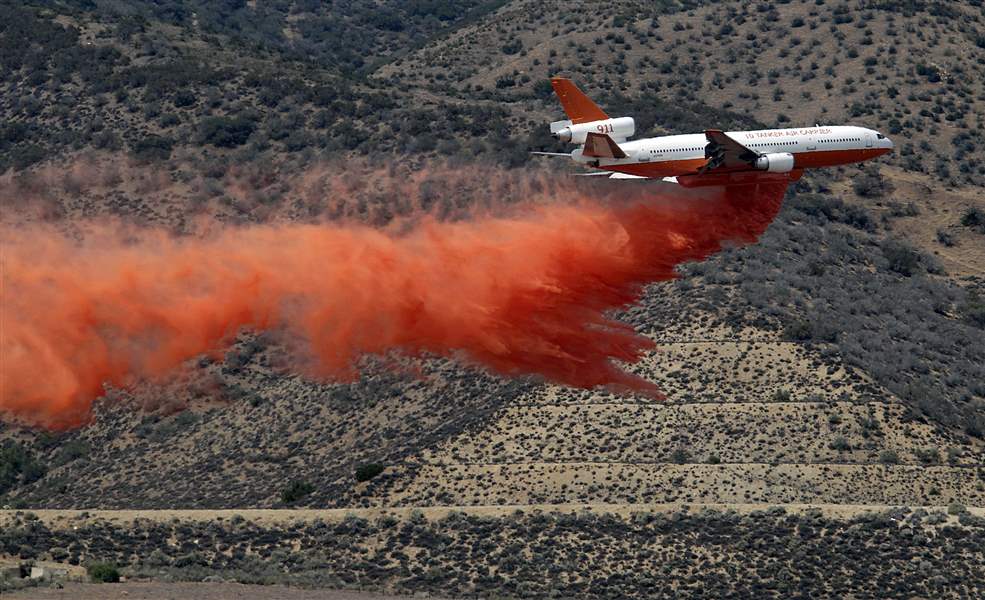
Containment of California fire doubles to 40 percent
6/3/2013
A DC-10 aerial tanker drops a line of fire retardant along the foothills of the Angeles National Forest where it becomes the Antelope Valley in an attempt to stop the Power Station fire if it comes that far, in Lancaster, Calif., Sunday.
ASSOCIATED PRESS

A DC-10 aerial tanker drops a line of fire retardant along the foothills of the Angeles National Forest where it becomes the Antelope Valley in an attempt to stop the Power Station fire if it comes that far, in Lancaster, Calif., Sunday.
LANCASTER, Calif. — Firefighters working in darkness doubled containment of a massive wildfire north of Los Angeles to 40 percent overnight, as cool, moist air moved in today to replace torrid weather.
The fire, which has fed on old brush that hasn’t burned in decades, did grow, but the moderating weather conditions gave crews the opportunity to make major gains, U.S. Forest Spokesman Matt Correlli said.
Firefighters were able halt the progress of the fire’s northeastern front, which had been moving into unoccupied desert lands north of Angeles National Forest.
Crews remained in place to protect structures in the rural hamlets of Lake Hughes and Lake Elizabeth, but flames were moving away from residential areas.
“The flames really laid down overnight,” said Nathan Judy, also of the Forest Service.
The blaze has burned about 46 square miles in mountain and canyons areas, destroying at least six houses and damaging 15 more.
The fire was fueled in part by chaparral that was “extremely old and dry” and hadn’t burned since 1929, U.S. Forest Service Incident Commander Norm Walker said Sunday at a news conference.
More than 2,800 people and 700 homes were under evacuation orders that were expected to last until late today or Tuesday.
About 2,100 firefighters took on the flames, aided by water-dropping aircraft, including three helicopters that stayed aloft through the night.
“We’re putting everything that we have into this,” Walker said.
The cause of the fire was under investigation. Three firefighters had minor injuries, but no one else was hurt.
Winds of about 25 mph and gusting as high as 40 mph had created “havoc” for firefighters for much of Sunday, LA County Deputy Chief David Richardson said.
Propelled by the strong winds, the fire jumped an aqueduct west of Lancaster, officials said.
George Ladd, 61, said among the structures burned was a cabin at Lake Hughes his family had owned since 1954 but sold just last week. He said he expected it may go up in flames sooner.
“We had always worried about that thing going off like a bomb,” Ladd said.
He walked through the ashes of his former cabin and the other destroyed homes Sunday.
“All of them are nothing,” Ladd said by phone from his home in nearby Palmdale later Sunday night. “A few scraps, a few pieces of wood with nails sticking out, but mostly just broken up concrete.”
Also in the West, two major wildfires are burning in northern New Mexico, though increased humidity and cloud cover has improved conditions.
The Thompson Ridge fire near Jemez Springs remains at nearly 3 square miles, according to today's status report. Forty to 50 houses were evacuated late last week.
The Tres Lagunas fire north of Pecos in the Santa Fe National Forest had grown by Sunday evening to nearly 12 square miles, causing smoke to spread across much of the region. It prompted the evacuations of about 140 homes, most of them summer residences.
Gov. Susana Martinez will attend a briefing today in Pecos on the Tres Lagunas fire.